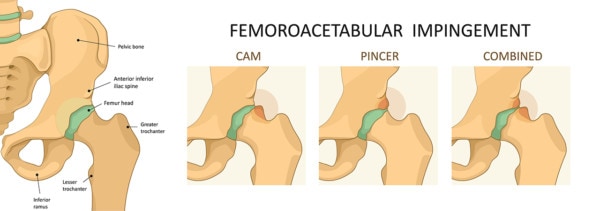Hip Impingement Causes: Is Instability the Culprit?
What is Hip FAI? Are there Hip Impingement causes that I can address, or is FAI inevitable? These are common questions patients ask themselves. The answer may be that your hip has been unstable for many years and those bone spurs that your surgeon wants to whack out may be all that’s protecting your hip joint! Let me explain.

Logika600/Shutterstock
One of the leading causes of hip impingement that we have seen is hip instability. Hip Impingement, or FAI, is very much what it sounds like. Something impinges, or pinches the hip joint and impedes the smooth movement of the head of the femur in the socket of the hip. Hip impingement can be caused by congenital structural anomalies, or develop over time. In this discussion we are talking about hip impingement which develops over time. Though there are many possible structural changes, there are two basic types of FAI; CAM where the ball of the femur is not perfectly round, and Pincer, where additional sections of bone have developed in the hip socket. Unfortunately, there has been an explosion of Hip FAI or Impingement surgery in the last several years as part of the “just cut it out” school of thought in Orthopedics today, however recent studies have shown that the additional bone involved in hip impingement is actually the body’s way of stabilizing an unstable hip joint, so removing what has been created for stability, leaves a now again unstable joint dealing with the trauma of surgery.
A recent Rochester study did a systematic search for clinical and science based studies which included hip impingement or hip instability. Of the 1,630 relevant studies they selected 4 studies which looked at both hip impingement and hip instability. These studies included 92 young patients with hip impingement. Hip instability was documented in 89 of the Hip Impingement subjects and various metrics were used to evaluate the degree of FAI and hip instability. Their conclusions were that high rates of FAI were present in patients with hip instability, and that the CAM and Pincer obstructions might force the femoral head out of normal position. Huh?
As Willy Wonka says, “Strike that reverse it…” as this study likely has it’s conclusion backwards. We believe that hip instability causes some forms of FAI and no part of this study was set up to discern which happened first, and therefore what caused what. Bone is very much alive and is a very interactive part of the musculoskeletal system. When it is acted upon by instability, it creates new bone, usually referred to as bone spurs, to stabilize a joint. Cutting those out rather than correcting the hip instability is akin to removing the trusses that support your roof at home and hoping for the best! Instead, in our experience, biologics like stem cells and platelets have been successful in stabilizing the joint without the trauma of surgery.
The upshot? It’s hard for many hip surgeons to contemplate that removing a bone spur could be a bad idea. However, if the bone spur formed to add stability and protect the joint as recent studies have shown, then hip impingement may be more a figment of the surgeon’s imagination rather than a real disease. In addition, while this recent study has found that hip instability and FAI are related, it got things backward as we’ve known for many years that joint instability actually leads to bone spurs and these are supposedly the villain in hip impingement. What if instead of the villain, they are just the innocent bystanders of an unstable hip!

NOTE: This blog post provides general information to help the reader better understand regenerative medicine, musculoskeletal health, and related subjects. All content provided in this blog, website, or any linked materials, including text, graphics, images, patient profiles, outcomes, and information, are not intended and should not be considered or used as a substitute for medical advice, diagnosis, or treatment. Please always consult with a professional and certified healthcare provider to discuss if a treatment is right for you.
